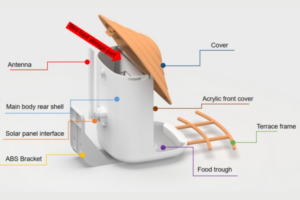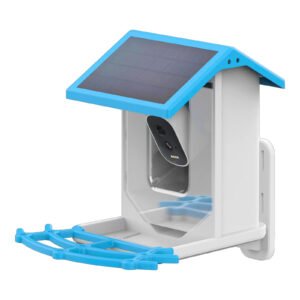Many bird enthusiasts face the challenge of attracting birds to a new feeder. Without the right approach, your feeder may remain untouched, leading to frustration. However, with the right techniques, you can quickly turn your feeder into a bird magnet. Read on to discover how you can encourage birds to visit and stay.
Attracting birds to a new feeder requires understanding their preferences and environment. Providing the right food, placement, and timing can make all the difference. Whether it’s your first time setting up a feeder or you’re trying to refresh your bird-watching experience, this guide will help you succeed in bringing beautiful birds to your feeder.
Curious about how to make your new feeder irresistible to birds? Let’s dive into the tips and tricks you need to follow to ensure your feeder becomes a go-to spot for local birds.
How Do You Get Birds to Come to a New Feeder?
To get birds to visit a new feeder, it’s important to place it in an environment where they feel safe and can easily spot the food. Start by filling the feeder with seeds that are attractive to a wide range of birds, like sunflower seeds. The placement of the feeder is crucial too; it should be in a quiet and sheltered location that offers good visibility for birds. Birds may need some time to discover the feeder, so be patient and ensure it’s placed in a place where they frequent.
How Long Does It Take for Birds to Get Used to a New Bird Feeder?
Birds may take some time to get used to a new feeder. On average, it could take anywhere from a few days to a couple of weeks. The birds need time to adjust to the new feeder and feel comfortable with the surroundings. Patience is key. During this time, it’s important to keep the feeder clean and consistently stocked with fresh food, which will encourage the birds to return regularly.
What Attracts Birds the Most?
Birds are attracted to feeders that offer their favorite foods, such as sunflower seeds, safflower seeds, and peanuts. In addition to food, birds are drawn to feeders that are placed in safe locations with natural cover. Vibrant colors, especially reds and oranges, can catch their attention as well. Ensuring a steady supply of fresh water and using bird-friendly scents can also make a difference in drawing birds in.
What is the Best Food to Put in Bird Feeders?
The best food for bird feeders depends on the species you want to attract. Common choices include sunflower seeds, suet cakes, peanuts, and nectar. Sunflower seeds are a favorite of many bird species, while suet is great for attracting woodpeckers and other insect-eating birds. For hummingbirds, nectar or sugar-water mixtures work best. It’s also important to keep the food fresh and replace it regularly to prevent spoilage.
What Smells Attract Birds?
Birds are attracted to smells, but their sense of smell is not as strong as that of mammals. However, certain scents like those from fruit, flowers, and even some bird food (like sunflower seeds and peanuts) can attract birds. Additionally, nectar feeders with sweet floral scents can draw in hummingbirds. It’s important to keep the area clean, as food odors can attract unwanted pests, which could discourage birds from visiting.
Where is the Best Place to Put a Bird Feeder?
The best place for a bird feeder is somewhere that offers a combination of safety and accessibility. Ideally, the feeder should be positioned near shrubs or trees, which birds can use for shelter. It should also be placed away from areas where predators like cats can reach, and in a location where birds can easily spot the food from a distance. If you have a balcony, you can also set up a feeder there, just ensure it’s high enough to avoid disturbances.
What Liquid Attracts Birds?
Nectar is the primary liquid that attracts birds, especially hummingbirds. You can create your own nectar by mixing four parts water with one part white sugar. Simply fill your feeder with the mixture, and place it in an area where hummingbirds can easily access it. Fresh water can also attract birds, so offering a birdbath with clean water can help create an environment that birds will visit often.
What Color Bird Feeder Attracts the Most Birds?
Bright colors, especially red, orange, and yellow, are known to attract birds. These colors mimic flowers and fruit, signaling food sources to many species. Hummingbirds are particularly drawn to red, so using a red-colored feeder for nectar can increase the chances of attracting them. Keep in mind that while colors are important, it’s the food and location that will ultimately determine the success of your feeder.
How to Attract Blue Jays and Cardinals?
To attract blue jays and cardinals, make sure your bird feeder is stocked with foods they love, such as sunflower seeds, peanuts, and safflower seeds. Both of these species are also attracted to large feeders and platforms where they can perch comfortably. For blue jays, offering peanuts in the shell can be especially appealing. Cardinals are ground-feeding birds, so placing food on the ground near your feeder can increase the likelihood of attracting them.
Why Don’t Blue Jays Come to My Bird Feeder?
If blue jays aren’t coming to your bird feeder, it could be due to several reasons. They may not find the right food, or your feeder might not provide the space they need to feed comfortably. Blue jays prefer larger feeders or platform feeders where they can spread out. Ensure that your feeder is located in a safe, sheltered area and that it has food they enjoy, such as peanuts or sunflower seeds.
Should You Feed Birds in the Summer?
Feeding birds in the summer is perfectly fine, but the types of food you offer should be adjusted. Birds still need food for energy during the summer months, but they will require foods that provide nutrients for breeding and molting. In the warmer months, you can focus on offering fruits, suet, and high-protein foods. Keep in mind that water is especially important during the summer, so make sure to offer fresh water daily.
How to Get Blue Birds to Come to Your Feeder?
To attract bluebirds to your feeder, it’s important to offer foods they prefer, such as mealworms, suet, and berries. Bluebirds are also drawn to natural habitats, so placing your feeder near a field or an area with plenty of open space is beneficial. Consider providing a nesting box as well, as bluebirds may be more likely to frequent your feeder if they have a safe place to raise their young.
Summary
Attracting birds to your new feeder takes patience, proper placement, and the right food. By following these simple steps, you’ll be enjoying regular visitors in no time.






